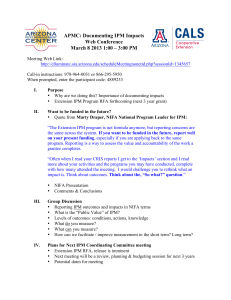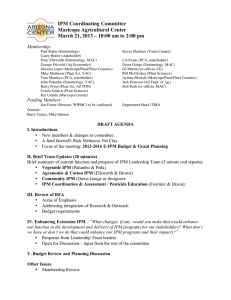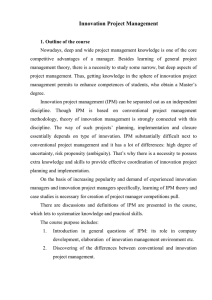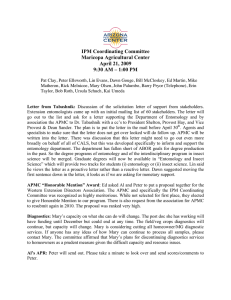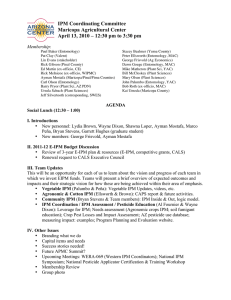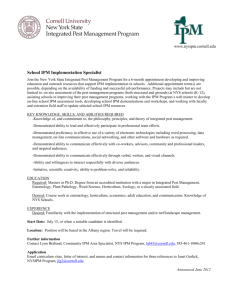IPM Coordinating Committee Maricopa Ag Center Oct 2, 2008
advertisement
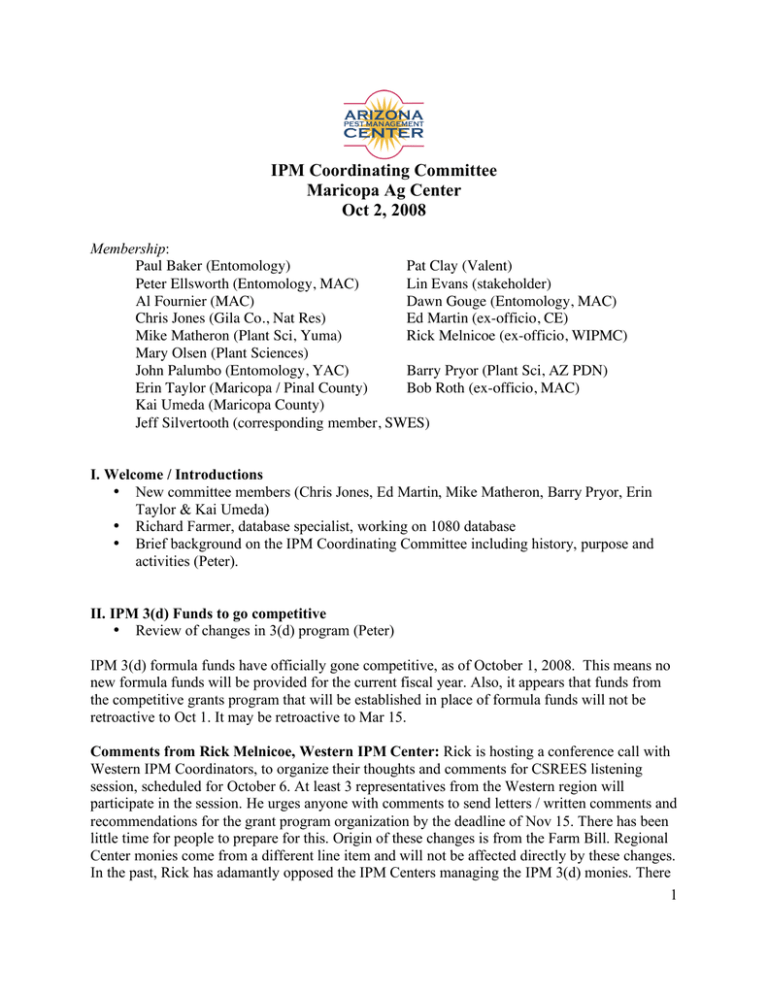
IPM Coordinating Committee Maricopa Ag Center Oct 2, 2008 Membership: Paul Baker (Entomology) Pat Clay (Valent) Peter Ellsworth (Entomology, MAC) Lin Evans (stakeholder) Al Fournier (MAC) Dawn Gouge (Entomology, MAC) Chris Jones (Gila Co., Nat Res) Ed Martin (ex-officio, CE) Mike Matheron (Plant Sci, Yuma) Rick Melnicoe (ex-officio, WIPMC) Mary Olsen (Plant Sciences) John Palumbo (Entomology, YAC) Barry Pryor (Plant Sci, AZ PDN) Erin Taylor (Maricopa / Pinal County) Bob Roth (ex-officio, MAC) Kai Umeda (Maricopa County) Jeff Silvertooth (corresponding member, SWES) I. Welcome / Introductions • New committee members (Chris Jones, Ed Martin, Mike Matheron, Barry Pryor, Erin Taylor & Kai Umeda) • Richard Farmer, database specialist, working on 1080 database • Brief background on the IPM Coordinating Committee including history, purpose and activities (Peter). II. IPM 3(d) Funds to go competitive • Review of changes in 3(d) program (Peter) IPM 3(d) formula funds have officially gone competitive, as of October 1, 2008. This means no new formula funds will be provided for the current fiscal year. Also, it appears that funds from the competitive grants program that will be established in place of formula funds will not be retroactive to Oct 1. It may be retroactive to Mar 15. Comments from Rick Melnicoe, Western IPM Center: Rick is hosting a conference call with Western IPM Coordinators, to organize their thoughts and comments for CSREES listening session, scheduled for October 6. At least 3 representatives from the Western region will participate in the session. He urges anyone with comments to send letters / written comments and recommendations for the grant program organization by the deadline of Nov 15. There has been little time for people to prepare for this. Origin of these changes is from the Farm Bill. Regional Center monies come from a different line item and will not be affected directly by these changes. In the past, Rick has adamantly opposed the IPM Centers managing the IPM 3(d) monies. There 1 has been some talk about that approach. USDA needs to manage these resources in a way that works for everyone. IPM 3(d) formula funding is a 30-year program and is not similar to the existing IPM competitive grants that support IPM research and outreach, including the Western IPM Center funds, which do fund some communication and infrastructural type projects, including development of strategic plans (PMSPs). Most likely, Feds will not go from old system directly to a competitive free-for-all. It is likely that there will be some effort to continue some kind of funding to states through the new competitive process, at least at first. Indirect costs are now a consideration too, since IDC will cut into the total funds available. [NOTE: Following the meeting, we learned that the RFP will have a 0% IDC rate.] Discussion was held on questions posed by CSREES. These questions were circulated as discussion points to be considered for the Oct 6 CSREES listening session. (1) What should be the primary goals and objectives of the program? Sustain some level of infrastructure (state based activities) and maintain stability. We expect the goals will be based on IPM Roadmap. (2) How can CSREES funding be optimized? Optimize by limiting IDC to 10%. (3) Should there be a limit on the number of proposals that can be submitted by each eligible institution? • Within-state collaboration should be a criteria for the RFP to ensure that cooperative projects are the ones that get funded. • Who is in a better position than the IPM-CC to write a successful proposal (than us)? No one. • As a committee, the APMC could broker proposals from AZ, as one comprehensive proposal or a collection of proposals. We should recommend a single, coordinated proposal from each state. • Let CSREES know: we don’t want to see a program where every state’s proposal is funded. (4) What criteria should be used in the proposal review and selection process? • However this is set up, it should reward effective infrastructure, i.e., infrastructure that was highly leveraged by other dollars and that was developing and implementing effective IPM programs. • Reward some amount of multi-state collaboration. • The concepts and priorities of the IPM Road Map should be an important component in the proposal review and selection process. (5) Should regional, multi-state /multi-institutional proposals be encouraged? “All IPM is local.” Consider a 2-tier system of state funding on the one hand and more regional, multi funds as a second sub-program (2 calls or one call with 2 levels). After discussion, the 2 group settled on a single call that has as a requirement documentation of successful infrastructure (as in criteria above) and could document some amount of multi-state or regional collaboration. (6) Should proposals addressing gaps in current program coverage be given greater emphasis in the evaluative process? No, other programs already serve these sectors. As long as proposals are addressing priorities of the IPM Road Map, then they are free to direct this resource to their own local priorities. (7) What limits should be set on funding and project duration? • Multi-year funding may be problematic because when you fund multi-year proposals because it freezes people out in alternate years when there is no call. The committee liked the idea of a bi-annual call, which provides more stability and allows better continuity of personnel, but is not so long that it freezes people/states/institutions out of funding for very long. • Limits set on funding? Assuming the funding available is the same as formula funds ($6.9 million, which doesn’t include Cotton IPM money ($1.2M)), and an estimated 70 eligible institutions, we calculated a likely maximum of award of $400k / year / state, though it may not be that high. Peter read summary comments from Western IPM Coordinator listserve to the group. III. APMC response to call for “Transformational Change” Background. The new UA president and provost are calling for “white papers” from departments, colleges, and other recognized groups that will change how UA does business. They are looking for suggestions on ways to improve efficiency, possibly through consolidation of departments / resources. This is a university-wide initiative. CALS may be less affected than some other colleges or units, as separate line in the state budget. However, the call for ideas may present an opportunity for the APMC to propose what it is we want to do with the APMC. Do we want to submit a white paper? Brainstorming session What is our goal in doing this? As an entity, we are not fighting for survival. One threat is: loss of federal formula funding. Our stability, at least, is potentially in jeopardy. How will we change? By advertising who we are and being recognized as an entity, maybe we will gain something we don’t have. We are the developmental and outreach arm for IPM in the state. Threats • Federal funds are going competitive. If we are not successful in competing for funds, do we have support of institution to continue at least as we are? This is also a potential opportunity to increase our funding. • One of our assumptions has been that the new competitive 3(d) funds will be brokered by the APMC. However, we have no real institutional authority to mandate that any 3 • proposals go through us. We do have the structure. We could indicate to the University that APMC is the most efficient way to interface with the new competitive Extension IPM call. This is why we need to write the paper. We need institutional authority. We have little and diminishing input on recruitment within many of our departments. This is because, as a rule, Extension faculty and those focused on applied research are in a minority in our departments. Discussion Points What will we ask for? • University-level authority to be the representing organization for federal Extension IPM funding competitive programs. • A stronger voice in recruiting decisions. • Make the case we are a center of distinction and need commitment and investment. • Stability; ensure continuity in a federal grant program • We are Influenced and driven by what stakeholders needs. Other Discussion Points: • Would we be more efficient if we were organized as a Department? Ability to capture resources, as a unit. • What if we organized recruitment not around departments, but around activities such as the CIS or the APMC? • In some way, we need to have a shared voice that will carry more weight. • We should emphasize the stakekholder input component of what we do. This gives us the moral authority to propose what we propose. • Could have a Dept of Extension; show the whole university how to do outreach. Maybe a department of applied sciences. • Evaluation is another issue. Depts don’t understand what we do. • Bring in food safety and security concepts. • We support multidisciplinary interaction • Organize merging of Ag Centers into “Education and Outreach” centers. • YAC met last week to discuss restructuring. One problem with dept of extension or something similar, faculty may lose some identity as part of an academic discipline. • Fair evaluation; Departments do not ask Ag Center resident directors for input • Along with outreach, emphasize applied science, which is often not a priority in departments • John: “I’m on board” for applied science / outreach / ag centers becoming a department. That is a bigger issue than the APMC. New faculty struggle: what is a good extension program? These people need input and need to be rewarded for proper programs, but departments don’t understand. Official decision in Extension: • According to Ed Martin, a white paper from Cooperative Extension will propose increasing the number and effectiveness of the specialists and increasing volunteerism. This “transformation” process is focused on academic departments. CE Does not want to 4 propose anything grand. Ed suggested the idea of integrating Cooperative Extension and the Outreach College, but this did not move forward. The fear was that the Outreach College focuses strictly on extended academic programs beyond the campus, and that Extension agents might be seen as a resource for teaching off-campus classes rather than focusing on Extension programs. College of Ag and Cooperative Extension won’t be changed too much, because we are the connection to the stakeholders. Gene has made it clear that he is not losing any faculty lines through this process. IV. Other Issues Paul Baker informed the committee that Pesticide Applicator Training (PAT) funding is still formula-based this year. Al Fournier briefly reviewed the PAT policy drafted by Baker, Ellsworth and Fournier and approved by the IPM-CC in 2006 and noted lack of implementation of this policy in the last fiscal year. Following the meeting, on October 3, Peter Ellsworth circulated a memo to IPM-CC via email, asking for nominations for Pesticide Coordinator. Next meeting: Dec 10 at Biosphere II, near Tucson (10am – noon) 5

